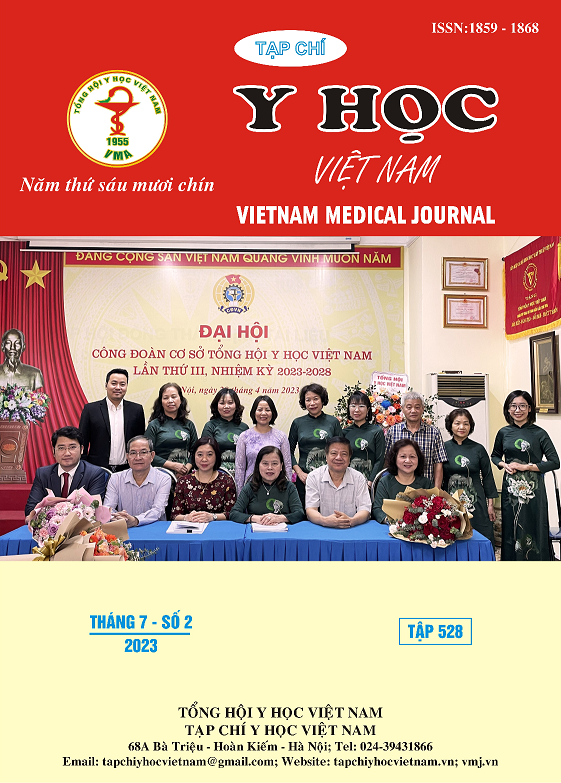CHARACTERISTICS AND RELATED FACTORS OF VERTEBRAL COMPRESSION FRACTURE IN THE OLDER ADULTS WITH OSTEOPOROSIS
Main Article Content
Abstract
Objectives: To investigate clinical and radiologic characteristics and related factors of vertebral compression fracture in the elderly with osteoporosis. Methods: This cross-sectional study was conducted on 296 older adults with osteoporosis at the Rheumatology and Neurosurgery department, and Rheumatology clinic, University Medical Center, from August 2022 to May 2023. Clinical symptoms, radiologic features, bone mineral density and related factors was collected. Results: Backpain (71,8% vs 11,8%, p <0,001) with the majority of VAS point between 4 – 6 (46,8%), height loss (61,8% vs 2,2%, p <0,001) and kyphosis (66,4% vs 2,7%, p <0,001) was more prevalent in older adults with vertebral fracture compared to those without fracture. On radiologic examination, the median number of vertebral fracture was 2 (1 – 2). T12, L1 and L2 vertebral bodies accounted for the most fractures. Wedge deformity (74,5%) and severe fracture (82,7%) was more frequent than other deformities and severity. In multivariate logistic regression model, age (OR 1,23; 95% CI 1,06 – 1,45; p <0,011), physical activity (OR 0,35; 95% CI 0,14 – 0,86; p <0,025), osteoarthritis (OR 0,25; 95% CI 0,07 – 0,92; p <0,037), fall (OR 3,47; 95% CI 1,34 – 9,58; p <0,013), previous height (OR 1,21; 95% CI 1,13 – 1,32; p <0,001), BMD in femoral neck (OR 0,00; 95% CI 0,00 – 0,03; p <0,001) was associated with vertebral compression fracture. Conclusion: Backpain, height loss, kyphosis can be useful to screen for vertebral fracture in the elderly with osteoporosis. Age, physical activity, osteoarthritis, fall, previous height, BMD at femoral neck are potential factors to be included in a diagnostic model for vertebral compression fracture.
Article Details
Keywords
vertebral compression fracture, osteoporosis, older adults
References
2. Fink HA, Milavetz DL, Palermo L, et al. What proportion of incident radiographic vertebral deformities is clinically diagnosed and vice versa? J Bone Miner Res. 2005;20(7):1216-1222.
3. Hà Văn Lĩnh, Nguyễn Lê Bảo Tiến, Phan Minh Trung, Võ Văn Thanh. Đặc điểm lâm sàng và cận lâm sàng ở bệnh nhân lún thân đốt sống ngực, thắt lưng do loãng xương. Tạp chí Y học Việt Nam. 2021;500(1):84-86.
4. Hồ Phạm Thục Lan, Mai Duy Linh, Đỗ Thị Mộng Hoàng, et al. Chẩn đoán gãy xương đốt sống (phần 2). Thời Sự Y học. 2011;63.
5. Sawicki P, Talalaj M, Zycinska K, et al. Characteristics of osteoporotic vertebral fractures in association with symptomatic status in postmenopausal women - a retrospective study of a single centre in Poland. Ann Agric Environ Med. 2021;28(4):654-658.
6. Noriega D, Marcia S, Theumann N, et al. A prospective, international, randomized, noninferiority study comparing an implantable titanium vertebral augmentation device versus balloon kyphoplasty in the reduction of vertebral compression fractures (SAKOS study). Spine J. 2019;19(11):1782-1795.
7. Kamimura M, Nakamura Y, Sugino N, et al. Associations of self-reported height loss and kyphosis with vertebral fractures in Japanese women 60 years and older: a cross-sectional survey. Sci Rep. 2016;6:29199.
8. Nakano M, Nakamura Y, Suzuki T, Kobayashi T, Takahashi J, Shiraki M. Implications of historical height loss for prevalent vertebral fracture, spinal osteoarthritis, and gastroesophageal reflux disease. Sci Rep. 2020;10(1):19036.


